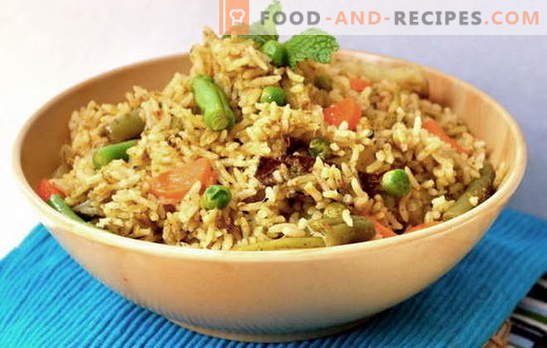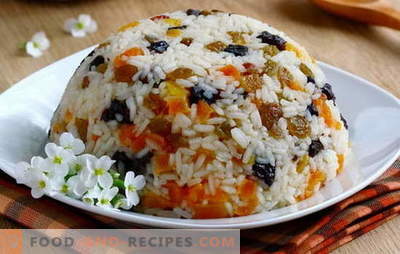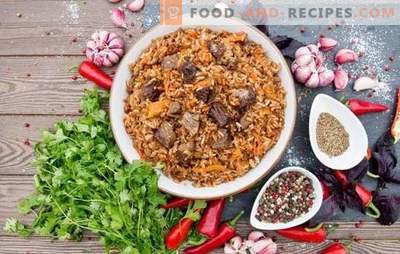
Pilaf, according to a translation from Sanskrit, is boiled rice.
Even ancient cookbooks, including Avitsenna’s written testimonies that have survived to our times, considered pilaf the most useful dish and wrote its recipe for the edification of descendants, repeatedly testify to the variety of additions to boiled rice.
That is, from what has been said, it follows that the popular “Güvech” with rice in the kitchen of the peoples inhabiting the Balkans is “a close relative of the pilaf” because it is prepared in the same way as pilaf in Central Asian cuisine Ingredients include more vegetables: eggplants, tomatoes and peppers loved in those places must be added to meat and rice along with onions and carrots.
Similar technologies for cooking rice with vegetables are found in Central and South America, South and East Asia. It is understandable: rice for several millennia of its cultivation, as a crop, has become frequent and even, in some cases, the main ingredient in the recipes of world culinary.
In general, vegetable pilaf is a very common dish found in every national cuisine on all continents of the planet.
Each national cuisine carefully preserves its culinary traditions as an integral part of its national culture and its historical development.
Vegetable pilaf - basic technological principles
Actually, in every recipe for pilaf, with the exception of fruit dishes, there are vegetables, because onions and carrots are also vegetables. But if we talk about the inclusion of other vegetables in the pilaf, then you need to remember: pilaf is not porridge, and the cereal part in it must be crumbly. Rice or other types of cereals, sometimes used to make pilaf - form the basis of the dish. The second part varies depending on the recipe.
Vegetable pilaf can be meat or vegetarian, consist of several types of cereals, it may contain fruits, dried fruits, nuts, candied fruits or vegetables. If pulses with dense and dry texture are added to the pilaf, the pilaf will remain crumbly. All other types of vegetables can be added to the pilaf, but at the same time it is necessary to take into account the content of vegetable juice in them, the excess of which can give the dish a completely new quality and even a new name. Actually, even very juicy tomatoes can be added to the pilaf, but for this it is important to balance the ratio of tomatoes and rice, drier and more moist ingredients. Vegetable pilaf can be prepared in two main ways. One of them consists in the sequential laying of all the ingredients and their subsequent heat treatment, in one common cooking container. In this way, pilaf is most often cooked in Central Asian cuisine: the most vivid and memorable examples are the Ferghana, Tashkent, Bukhara, Samarkand pilaf. At the same time, a minimum of vegetable ingredients in Uzbek pilaf is compensated by enhanced accompaniment of snack dishes from fresh vegetables and fruits.
But in the more ancient and, as it turned out, the more common form of cooking, which came from the ancient masters of Oriental and Arabic cuisine, very often there is a technology of separate preparation of the constituent parts of pilaf, groats and meat and vegetable or fish and vegetable parts, with their subsequent connection directly in the serving dish, and sometimes these components of the dish are served even in separate dishes.
If so, then vegetable pilaf is a popular and loved dish all over the world, because even pilaf can be added to it, where rice is, in fact, a side dish or vegetable stew with rice in modern culinary ideas. Whatever it was, but boiled rice is tasty, which means that it remains to supplement your culinary notebook with new and tasty recipes.
Recipe 1. Pilaf with vegetables in Bulgarian - “gyuvech” with rice or “Slavyansk” stew
Ingredients:
Salad pepper (fleshy, sweet)
Chicken thighs 1.5 kg
Tomatoes 500 g
Ground coriander
400 g rice
Bay leaf
Onion 0.5 kg
Butter 120g
Carrot red 350 g
Ground pepper (fragrant and black)
Boiled ham 700 g
Red, ground pepper
Blue eggplants 200 g
Sugar
Olives, salted 250 g
Salt
Fresh parsley 100 g
Cooking:
All vegetables are washed, peeled and cut: peppers, onions and eggplants - in strips, olives - in rings, chopped parsley, and tomatoes without skin are cut into small cubes. Chicken legs are cut in half in half by joint, ham is cut into large pieces. Rice washed and kept in cold water. Onions are fried with carrots, adding a spoonful of butter. The meat is also fried in butter, after which passaged onions, carrots and a cup of water are added to it. Added rice. Another cup of water is taken and all the spices are stirred in it. Tomatoes are stewed with a little oil and spice water is poured in: this is a sauce with a sharp and sour-sweet taste. All other vegetables are also individually fried and added to the tomato sauce. When the vegetables in the sauce boil, put them in a saucepan with meat and rice. Check the readiness of rice. It should be slightly undercooked, and some liquid should remain in the pan. Put chopped greens on top, make a few holes so that the liquid evaporates from the bottom of the pan and cover with a lid. Remove from heat, and serve after 15-20 minutes.
Recipe 2. Vegetable pilaf with lentils and onion dressing - traditional Arabic cuisine
Ingredients:
Rice (thin, long grain)
Green lentils
Oil (olive or cream)
Bow
Pepper and Zira, ground
Salt
Unsweetened Yogurt with Chopped Greens
Cooking:
Rice and lentils pre-wash, hold in water and boil. Cut the onion into rings and fry it in oil until golden brown. Combine the ingredients of the dish in the same container, season with spices. You can put onion rings on top of the pilaf. Serve green yogurt to the pilaf.
Recipe 3. Vegan Provencal Vegetable Pilaf
Ingredients:
Tomatoes 300 g (net)
Zucchini, peeled 200 g
Butter 50 g
White rice 400 g
Onions 150g
Garlic 20g
Tomato Sauce 150 ml
Olive oil 70 g
Vegetable broth 500 ml
Provencal herbs
Pepper (red and yellow), sweet 250 g (net)
Parsley (greens)
Cooking:
Prepare the vegetables and cut them into cubes, 1x1 cm. Remove the seeds from the tomatoes and peppers. Combine tomato sauce with dry Provencal herbs, chopped garlic and half of olive oil. Use the other half for frying vegetables, except tomatoes — add them to the zucchini, onions and peppers last. Add tomato sauce to roasted vegetables, and immediately after boiling, remove from the heat.
In the skillet, melt the butter, put the prepared rice in it, heat it and, pour in the hot vegetable stock, cover the saucepan with the lid. Simmer until half cooked, then add the vegetables in the sauce and simmer until tender. At the end of cooking, sprinkle with chopped greens.
Recipe 4. Pilau with vegetables and pork
Ingredients:
Brisket 200 g
Cooked rice 900 g
Asparagus, green 250 g
Butter 50 g
Pork tenderloin 800 g
Tomatoes 1.2 kg
Greens: celery (leaves and roots), lemon balm, dill
Wine Vinegar 30 ml
Shallot 120g
Pepper (a mixture of ground peppers)
Carnation
Vanilla
Meat broth (chicken) 150 ml
Sugar 40g
Beer, light 150 ml
Balsamic vinegar 100 ml
Cooking:
Slice asparagus, chop fresh greens and onions. In a small container, mix the wine vinegar, pepper, sugar. Boil and let cool. Pour asparagus mixed with greens with this dressing, mix thoroughly and set aside. Salt the tenderloin, rub with a mixture of peppers and bake in the oven until browned. When cool, cut into strips. Mix balsamic vinegar with pepper and chopped lemon balm. Marinate the sliced strips for 2 hours.
Slice the brisket and heat it in a deep cast iron pan until the fat is melted. Drain it and mix with beer. Pour back by removing the roast brisket. Put pork in the mixture and simmer.
In another bowl, melt the butter, add chopped celery root (50 g), chopped shallots, lemon balm and stew slightly, pour in the broth, add the chopped tomatoes, without the skin and grains, ground cloves and vanilla, bring the sauce to a boil and pour it into the stew meat.
Put the rice on the dish, top the meat and marinated asparagus.
Recipe 5. Vegetable pilaf with carrots in Korean style, breast and green peas
Ingredients:
Rice "Jasmine" 400 g
Korean carrots 250 g
Fresh green peas 200 g
Chicken Breast 1.2 kg
Ghee 150 g
Broth 1.5 l
Sour cream 300 g
Saffron
Pepper Mix
Cooking:
Prepare the ingredients: wash the meat and cut into cubes. Soak rice in clean and cold water.
Heat the oil and put carrots in it for five minutes. Add the breast pieces and fry until crusty, and then put the rice on top and pour in the broth, combined with sour cream and spices. When the rice is half ready, add the washed peas. Stew until soft peas.
Vegetable Pilaf - Tricks and Tips
- Try to undercook rice a little while cooking pilau. It will be steamed for some time until the temperature inside the dish reaches below 60C, and continue to absorb water. Try the rice and turn off the stove right away when it stops crunching, but it will still be hard enough. Well, if at this point in the pot will remain a little non-evaporated liquid.
- The pilaf is cooked in an open dish, but as soon as all the ingredients are placed in the pan, close the lid so that all the flavors of the dish combine and soak.
- Fresh chopped greens do not need to be subjected to prolonged heat treatment, given its brittle and delicate structure. In addition, after a long digestion, its aroma disappears from the dish. It is enough to grind it to throw in a boiling dish, cover and let stand: the hot steam will bring it to the desired degree of readiness.
- Salt in a hot dish is felt more than in a warm one, which can already be eaten. Remember this when salting rice, especially since it requires more salt. But do not rush to salt the rice at the beginning of cooking. Better to do it 10 minutes before it ends.























